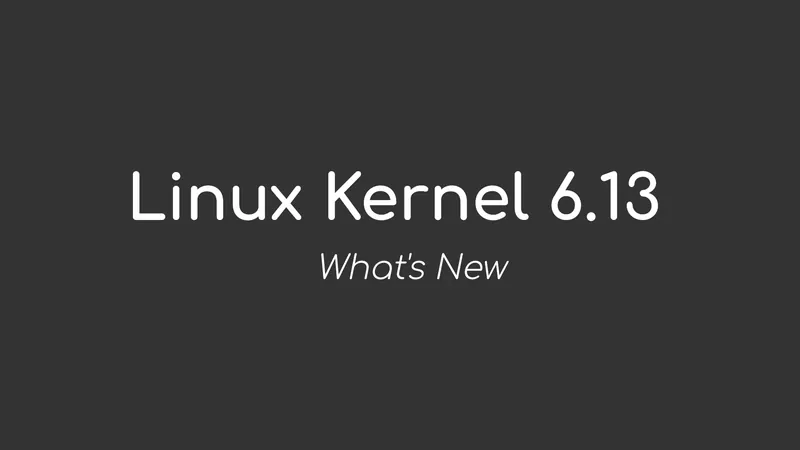
Linux Kernel 6.13 Officially Released: Discover the Groundbreaking Changes!
2025-01-19
Author: William
In a highly anticipated announcement, Linus Torvalds has officially unveiled Linux Kernel 6.13, marking yet another milestone in the evolution of Linux.
This latest stable version brings a plethora of new features, improved hardware support, and significant enhancements aimed at refining user experience and performance.
Key Features and Improvements:
One of the standout advancements in Linux 6.13 is the introduction of "lazy preemption" support, which simplifies the kernel's preemption logic. This model optimizes scheduling by delaying preemption requests to synchronize better with system ticks, particularly beneficial for processing efficiency.
For those using ARM architectures, Linux 6.13 now supports running in protected virtual machines under the Arm Confidential Compute Architecture (CCA), offering heightened security for sensitive applications. Additionally, the introduction of user-space shadow stack support for AArch64 (ARM64) via Guarded Control Stack (GCS) further bolsters system integrity.
On the hardware front, enhanced support has been added for Intel and AMD processors, including the adoption of the amd-pstate CPU frequency driver as the default choice for newer AMD Epyc processors. Users will also benefit from new thermal threshold support that can dynamically be added or removed through user space, alongside various updates aimed at improving device management.
Networking Innovations:
Networking capabilities have seen significant advancements in this release. The Routing Netlink (RTNL) lock is now transformed into a per-network-namespace lock, drastically reducing contention in environments with heavy namespace workloads. There's also a newly implemented IRQ suspension mechanism that can effectively pause IRQs during intensive application workloads, streamlining resource management.
Filesystem Enhancements:
The filesystem sector received vital updates, too. The F2FS filesystem introduced a device aliasing feature, allowing users to efficiently manage space by deleting aliased files. At the same time, the XFS filesystem gained basic support for atomic write operations, critical for maintaining data integrity during writes.
Moreover, performance improvements were made across various filesystems, including EXT4, Btrfs, and exFAT, reflecting the ongoing commitment of developers to enhance Linux’s scalability and responsiveness.
Expanded Driver Support and Real-Time Features:
Linux 6.13 also heralds extended hardware support with updated drivers for an array of devices, such as the Adreno A663 GPU, Oracle's latest processors, and newer RealTek audio chips, enhancing compatibility with cutting-edge technology.
Another exciting feature is the addition of real-time computing capabilities to the LoongArch architecture, along with support for pointer masking and advanced tracing events in Rust, marking strides in performance optimization and developer usability.
What’s Next?
Download Linux Kernel 6.13 now from Linus Torvalds’ git tree or the kernel.org website if you’re eager to compile it yourself. However, for a smoother experience, it’s wise to wait for your distribution to integrate this latest release into its stable repositories.
Looking ahead, the merge window for the next significant release, Linux 6.14, is now open, with the first Release Candidate (RC) set to debut on February 2nd. The stable version is projected for launch at the end of March 2025, so keep your eyes peeled for what’s coming next in the world of Linux!
Stay tuned for more updates and enhancements as Linux continues to evolve and adapt to the needs of its diverse user base!









 Brasil (PT)
Brasil (PT)
 Canada (EN)
Canada (EN)
 Chile (ES)
Chile (ES)
 Česko (CS)
Česko (CS)
 대한민국 (KO)
대한민국 (KO)
 España (ES)
España (ES)
 France (FR)
France (FR)
 Hong Kong (EN)
Hong Kong (EN)
 Italia (IT)
Italia (IT)
 日本 (JA)
日本 (JA)
 Magyarország (HU)
Magyarország (HU)
 Norge (NO)
Norge (NO)
 Polska (PL)
Polska (PL)
 Schweiz (DE)
Schweiz (DE)
 Singapore (EN)
Singapore (EN)
 Sverige (SV)
Sverige (SV)
 Suomi (FI)
Suomi (FI)
 Türkiye (TR)
Türkiye (TR)
 الإمارات العربية المتحدة (AR)
الإمارات العربية المتحدة (AR)